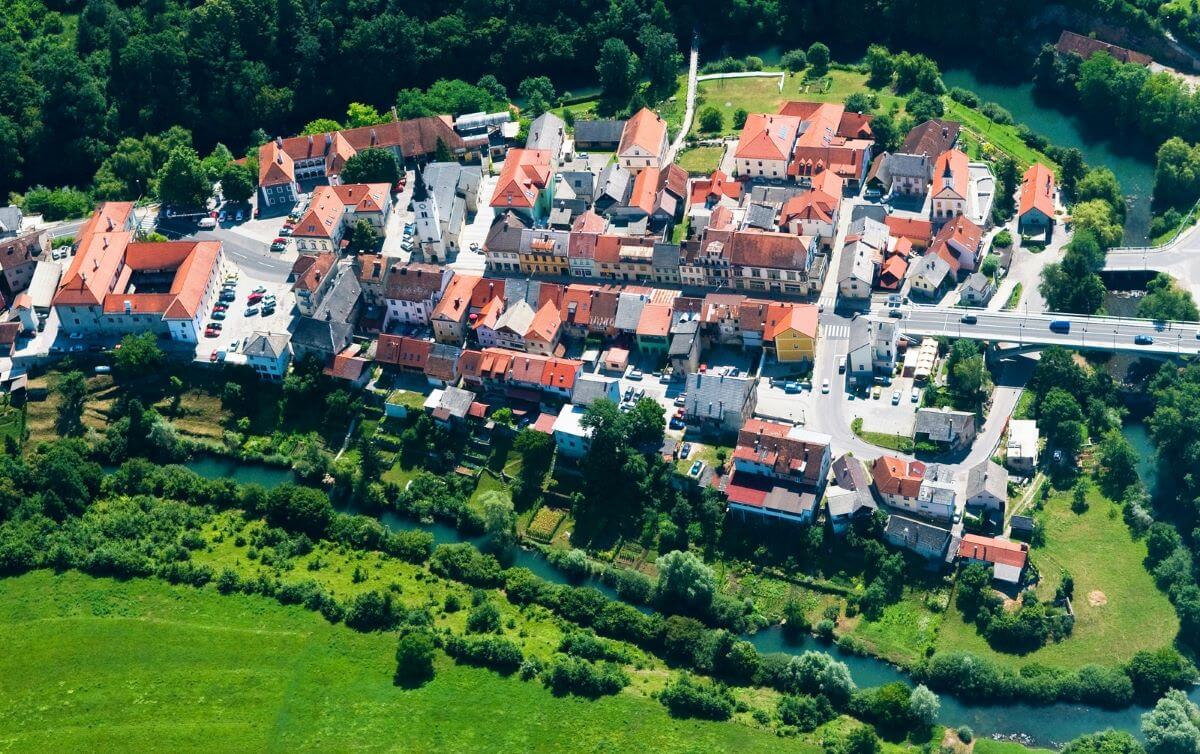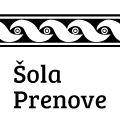Surrounded by rivers, tradition and culture
With its star-shaped paths leading in all directions, Črnomelj, the largest town in Bela Krajina, is the best place to start discovering this part of Slovenia – between the hills of Gorjanci and the rivers of Bela krajina.
Treasures of Bela krajina
In the centre of Črnomelj, on the Square of Freedom (Trg svobode), you will surely notice the oldest and grandest building in town. The Črnomelj Castle (1), which today is the seat of the municipality, controlled access to the area around the confluence of two rivers as early as the 12th century. In the cellar of the castle, you will find the Treasury (2). A virtual and sensory encounter with the unique features of Bela krajina will satisfy your wanderlust! After exiting this place brimming with special energy, start discovering the largest town in the Bela krajina region.
From the car park in front of the castle, look towards Stonič Castle (3), which was created by joining three town houses. Under the arch of this interesting building, you can follow the Na utrdbah Street where, after a few steps, you turn left into a narrow passage between the houses. At the and of the passage, turn right towards the bridge.
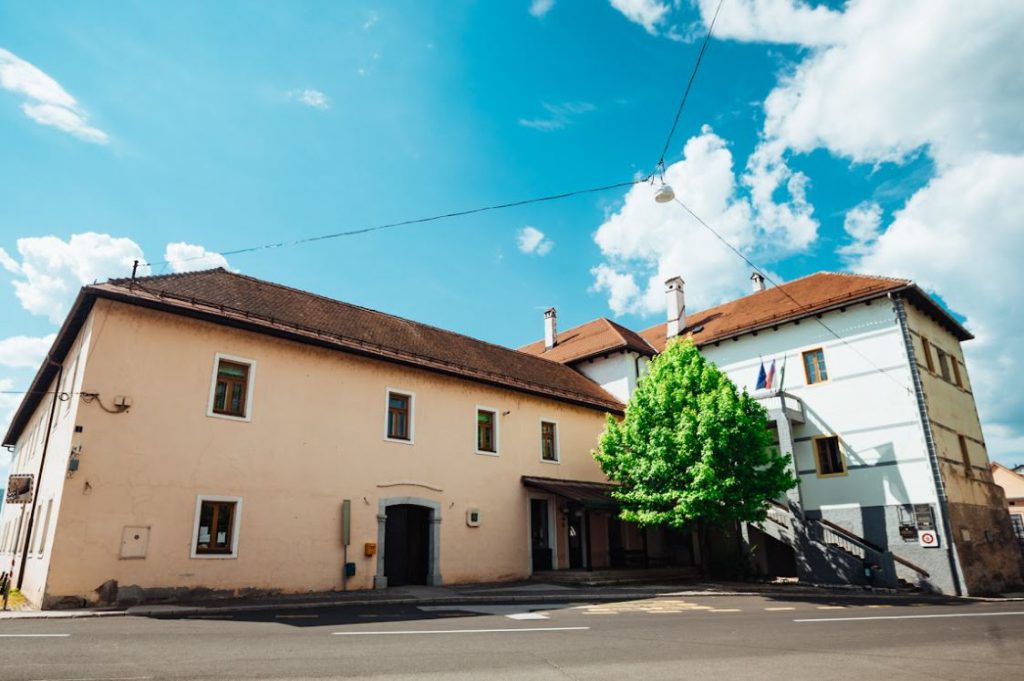
Towards the confluence
If you look across the crossroads, you will see the Koren House (4), whose corner pier marks the southern entrance to the town. This early 20th century building now hosts an organic farmers market. Continue the path towards the main bridge. On its left, take the stairs down to the point from which you have a beautiful view of the Črnomelj Triple Bridge (5). At the end of the stairs, you can come closer to the confluence of two rivers. The Lahinja and Dobličica rivers have been creating a welcoming space for people since ancient times and their riverbeds are home to many fish, birds and other animal and plant species.
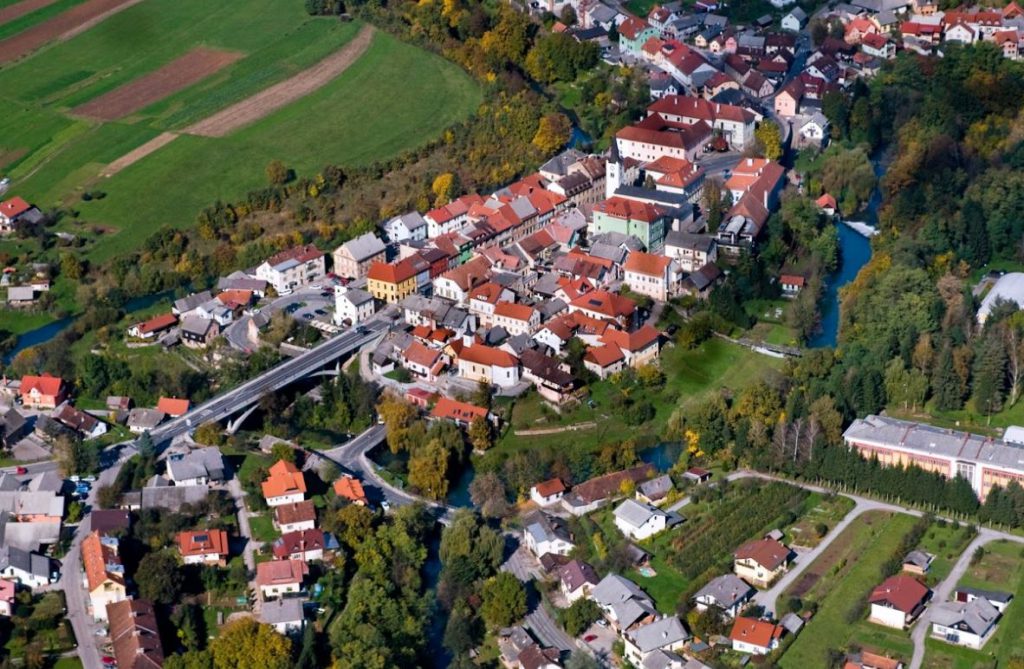
Hint: Complement your river views with the tastes of Bela krajina. To the right of the three bridges, find Muller Inn, a family-run restaurant with a tradition of serving local delicacies.
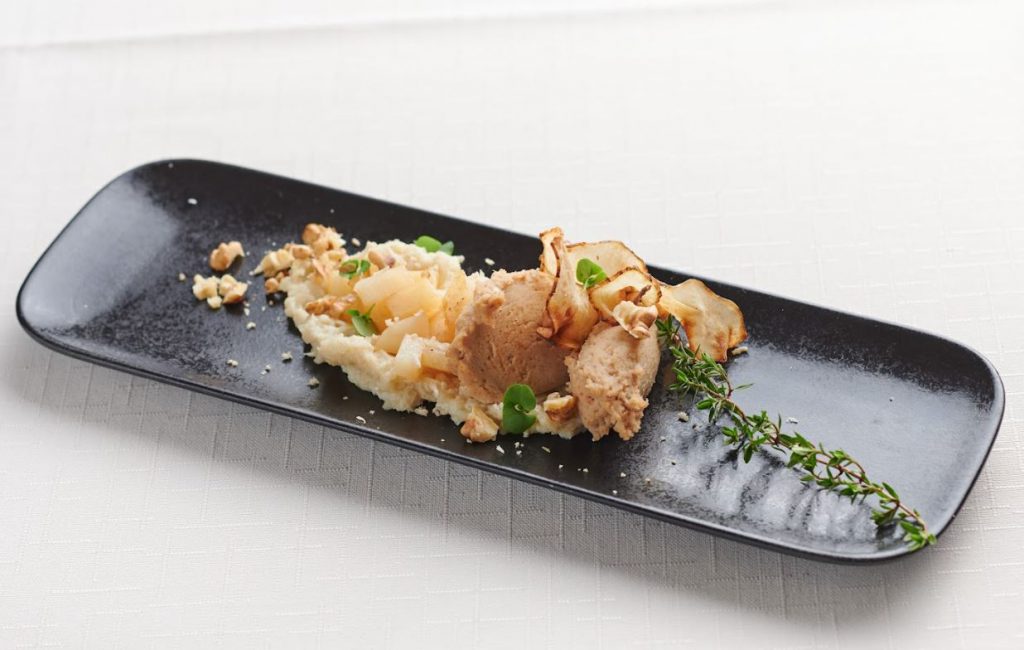
A visit to the bats and Črnomelj in all time periods
From the river bend, climb the stairs to the Church of the Holy Spirit (6) with its mosaics and apse dating from the late antiquity. Inside the church, which is now a cultural event venue, you will find a screen that offers you a view of the church attic, which in summer is one of the largest bat maternity roosts in Slovenia. After exiting, turn left towards Primožič House (7). The former home of an important school teacher now houses the craftsmen of Bela krajina. Here, you can buy local handicraft products. Follow the path towards the parish house and Pastoral Centre (8). In this area, important finds from prehistoric, ancient and medieval times have been discovered. In the exhibition A Town beneath the Town you can see them through the glass beneath your feet.
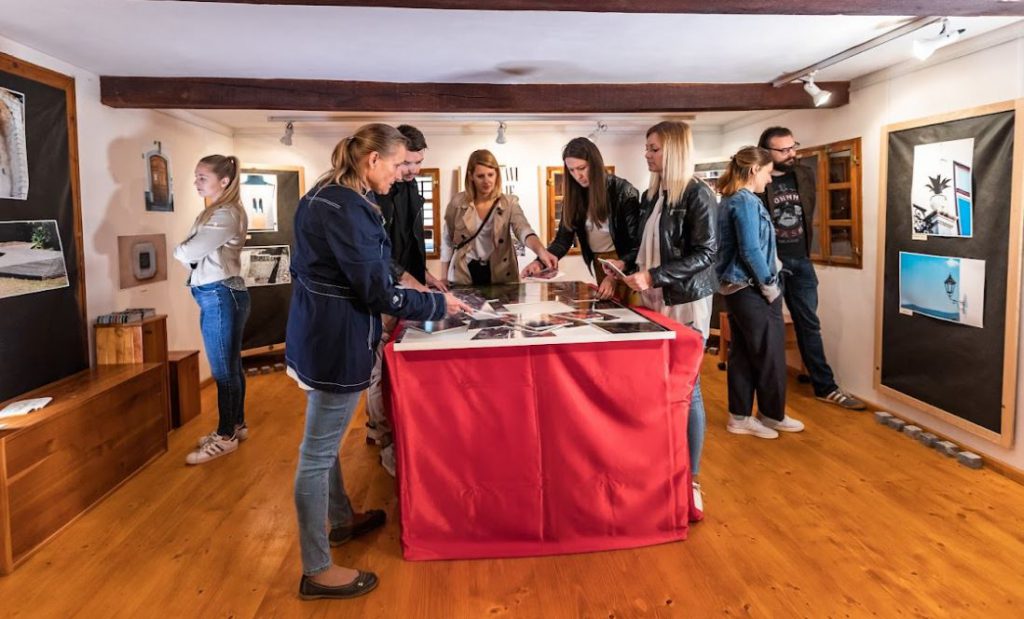
Along culture street
Continue on from the church and walk along the street the locals know as culture street. In the birth house of Miran Jarc (9), poet and writer after whom the street is named, you can visit the Črnomelj Museum Collection. After experiencing the story of three thousand years of life in this part of the world, continue your way to Petrov Square, where the Old School (10) has stood for more than a hundred years. This distinctive green building is now home to the Music School. If its doors are open, you can look up at its stone staircase. From the square, walk down to Staneta Rozmana Street where, on the corner, you will find the Visitor Centre (11) where you can by certified products of the Belokranjsko/Bela krajina Finest collective brand.
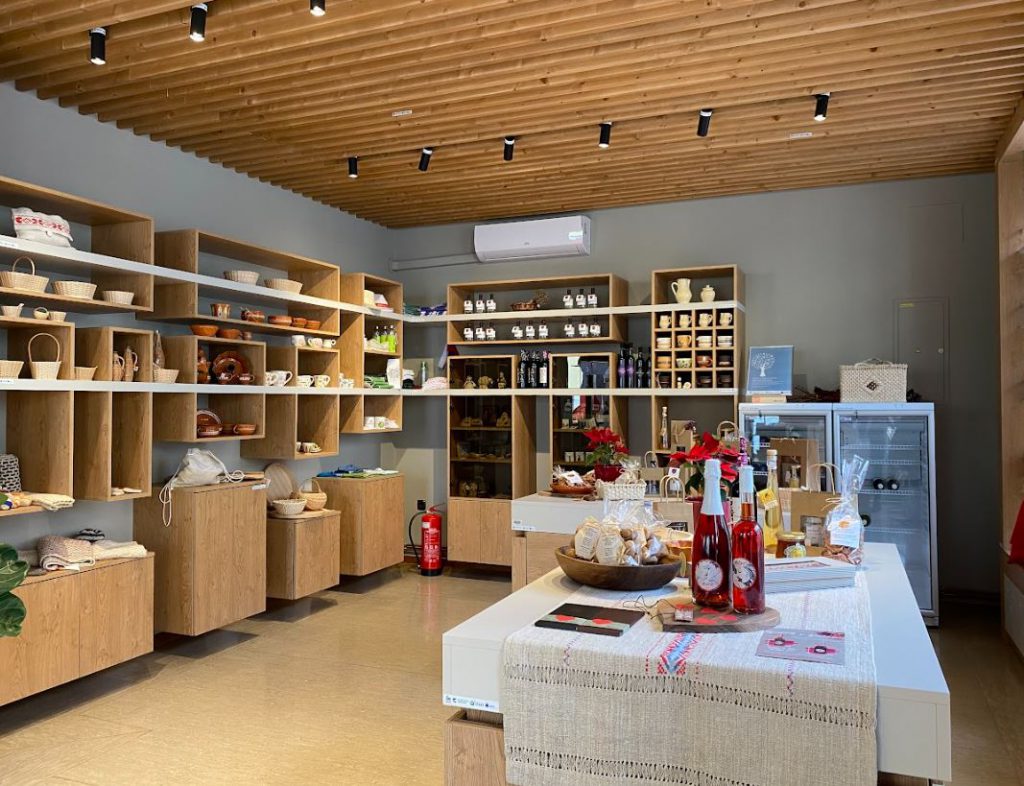
Hint: Before continuing on, take a short and sweet break in the local patisserie, which in summer also extends to an outside patio on Petrov Square.
To the tributes to God and life
After exiting the Visitor Centre, you will see the Sinkovič House (12). This former inn and butcher’s shop retains its original appearance from the early 20th century. From here, walk towards the parish church of St Peter (13) featuring a fresco of St Christopher on the bell tower, and explore its interesting interior. Next to the church, stop at the Drinking fountain (14), which was designed as a tribute to life from birth to death and also serves as a reminder of the importance of water. Have a sip! From here, turn towards the Loan House (15) with its articulated facade and walk in the direction indicated by the spiral-shaped drain on the fountain. You will reach the Komenda (16) of the former German knights. On the picturesque building which is now home to the courthouse, find a stone slab with the coat of arms of the Teutonic Order.
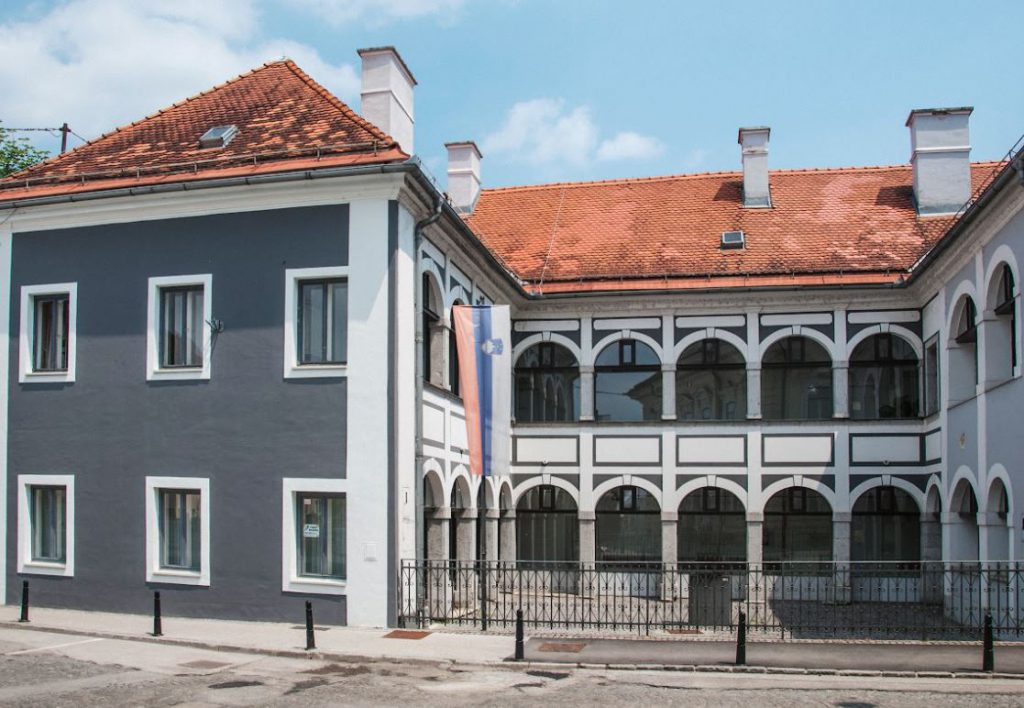
Peace above the town
Continue along the pavement toward the upper part of Črnomelj. After a few minutes, you will reach the stairs which lead past the Memorial to the Fallen in World War I (17) up to the Šolska street. When at the end of the street you cross the main street, you will find yourself in Griček Park. Take the path to the top of Griček with its National Liberation Struggle Memorial (18). The memories of the great war brought you to a viewpoint of peace. Sit on a bench and enjoy the view of Črnomelj. From Griček, descend to the other side where the path takes you to a road leading past a school, a gym and a library to a place of cultural creativity.
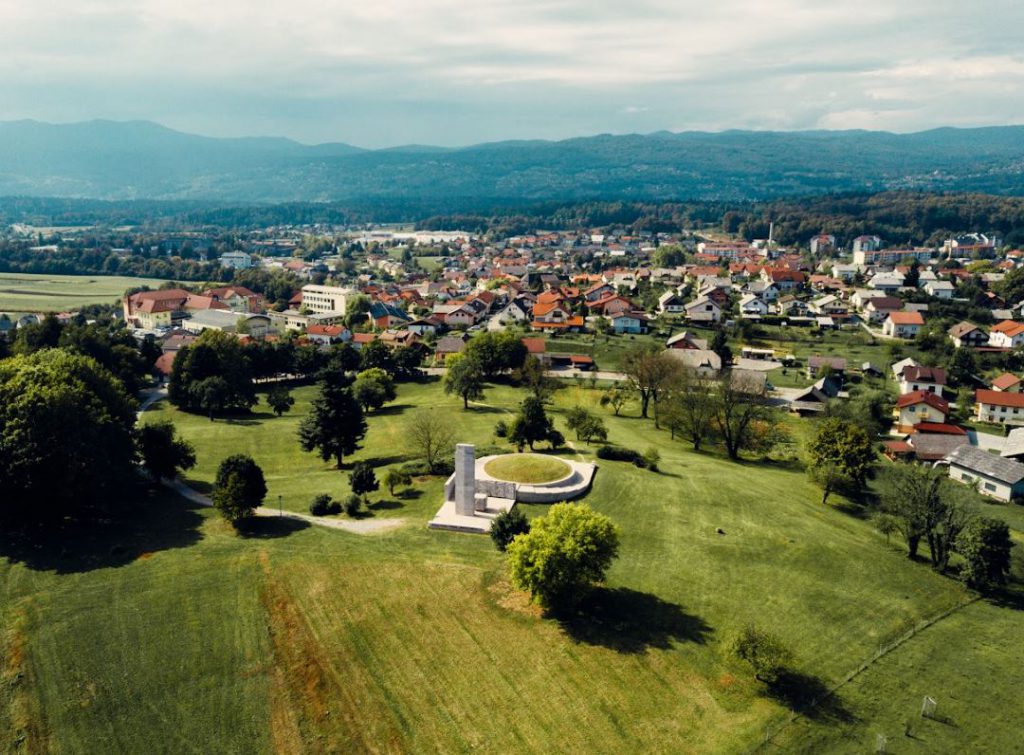
To the venues of major events
At the beginning of the street named after Oton Župančič, a famous poet of Bela krajina, is the Črnomelj Cultural Centre (19). During the Second World War, when Črnomelj was part of the first liberated territory of Slovenia, the foundations of the future state were being laid here in important meetings. We are reminded of this by the statues of national heroes and the relief of Jakob Savinšek. The cultural centre features the exhibition Homeland is Culture. From here, a 10-minute walk towards the railway station leads to the Jurjevanska Draga natural amphitheatre (20), where the oldest folklore festival in Slovenia is held every June. Jurjevanje attracts folklore groups and visitors from all over the world.
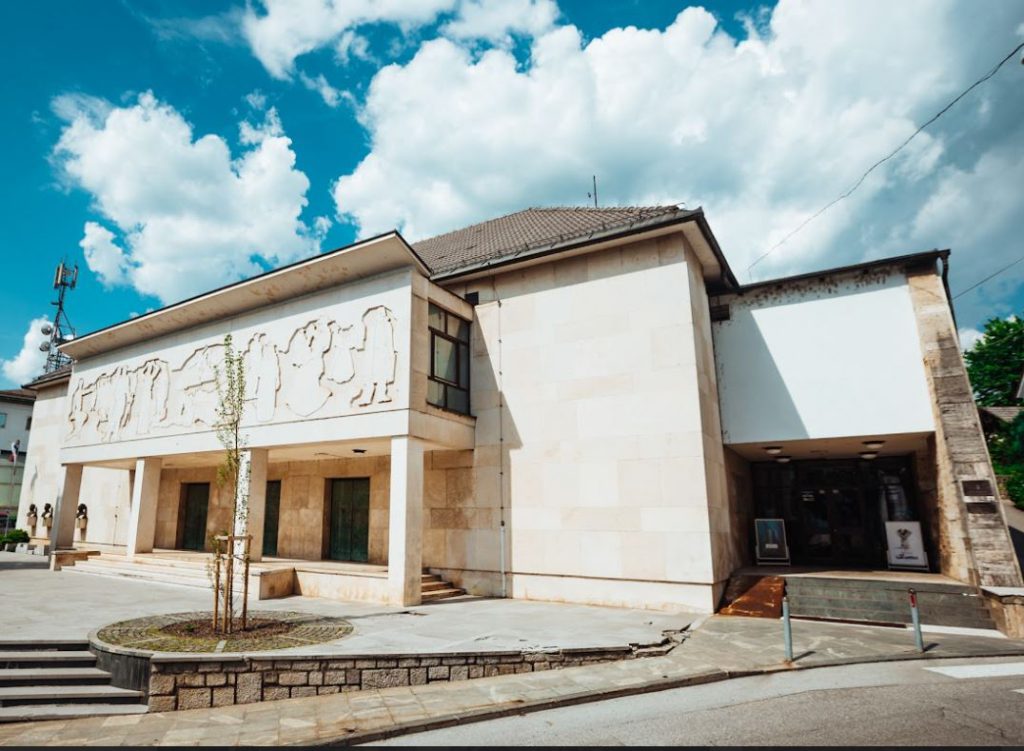
Hint: Before turning towards Jurjavanska Draga, stop at the Sweet & Rich café and patisserie which, among other things, is famous for its homemade ice cream.
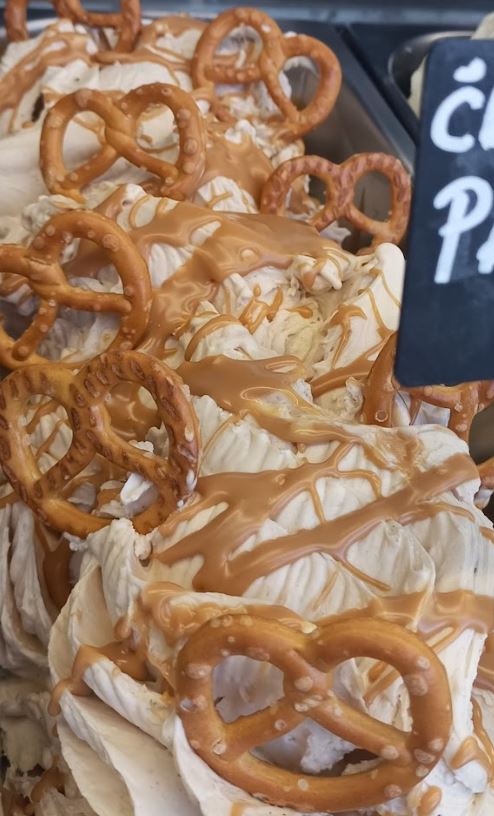
To the monuments of the former and present state
Continue along Kolodvorska Street to the Slovenian Independence Monument (21). Plaques in the ground recall important points in the history of Bela krajina. On the other side of the street, at the Partisan Airfield Memorial (22), you can see the coat of arms of Yugoslavia which was also made possible with the help of aircrafts landing in Bela krajina during World War II. Linked to this period is also the steam locomotive (23) by the railway station, which was used to provide electricity to Črnomelj during the war.
Suggestions for a hike
A visit to the black olm
Slovenia is the land of the famous human fish, and Bela krajina is the only home of its unusual relative, the black olm (Proteus Anguinus parkelj). Almost completely black, this cave-dwelling amphibian with red gills lives only in underground waters in a small area of about 100 km2 around Črnomelj. You can get to know this special creature at the Black Olm Information Centre in Jelševnik.
From Črnomelj, you can reach the information centre on foot or by electric bike, which you can rent at the parking lot in front of Črnomelj Castle.
A little less than half an hour’s walk or 10 minutes’ cycling will bring you to the starting point at Svibnik. From this point, which can also be reached by car, a well-marked, gently sloping path through the forest leads you to the Black Olm Information Centre. The Info Centre, located at the Zupančič homestead, is a half-hour walk away. If you book your visit in advance, locally-sourced refreshments await you at the homestead, in addition to learning about the black olm, an endemic of the Bela krajina.
From Jelševnik, a circular path past the solar power plant leads you back to Svibnik. If you prefer, you can also head down towards the beginning of the Črnomelj bypass at the wooden bridge.

More information: Črni močeril or TIC Črnomelj, Ulica Staneta Rozmana 1, +386 40 883 162.
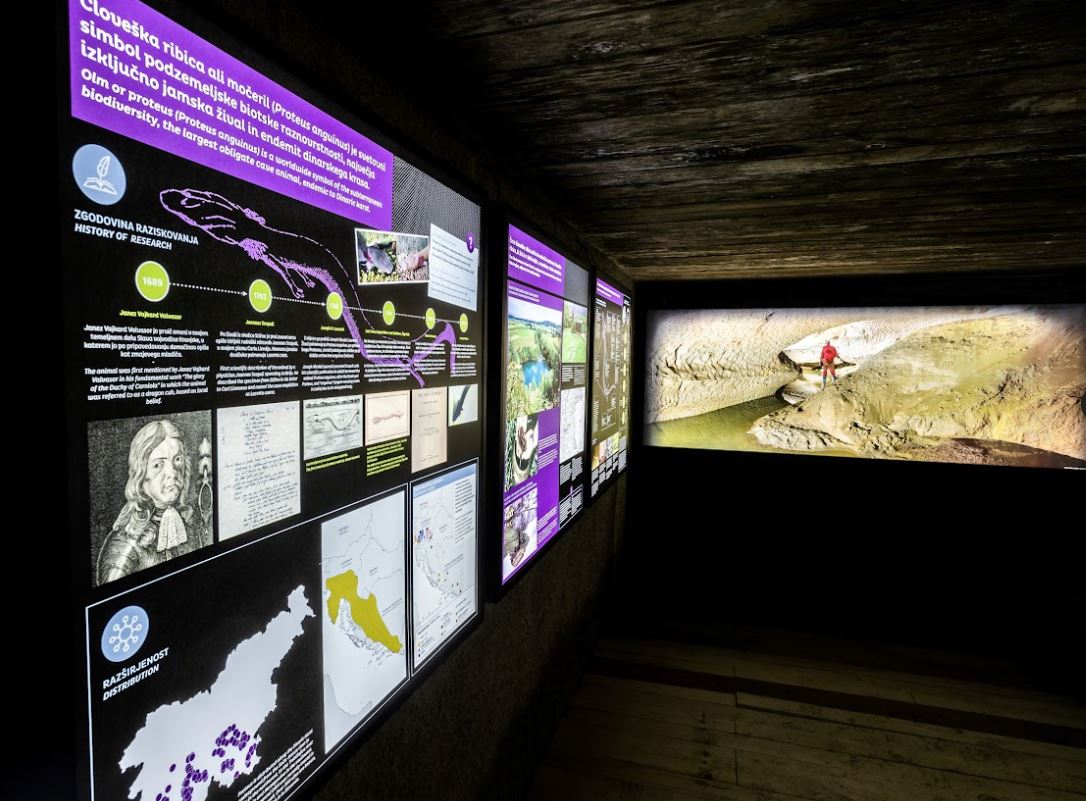
ČRNOMELJ CASTLE
The oldest and most imposing building in Črnomelj dates back to the end of the 12th century. The castle built on the narrows of the river bend controlled the entrance to the town. It was owned by the Črnomaljski, one of the oldest knightly and noble families from the Carniola region. The key defensive structure of the town has undergone several reconstructions over the centuries, and its current appearance dates from the 20th century. Today, the castle is the seat of the Municipality of Črnomelj.
Trg Svobode 3 (The Municipality of Črnomelj, contact information: +386 7 306 11 00, obcina@crnomelj.si)
TREASURY
The once abandoned and now beautifully renovated space in the cellar of the Črnomelj Castle, which has won the Big See Award for Architecture, is the best starting point for discovering the special characteristics of Bela krajina. Here, the natural, cultural and ethnological treasures of the area between the Gorjanci Hills and the Kolpa River are presented in an interactive and tactile way.
Trg Svobode 3 (contact information: TIC Črnomelj, Ulica Staneta Rozmana 1, +386 40 883 162, tic.crnomelj@ric-belakrajina.si)
STONIČ CASTLE
The building, which was created in 1768 by combining three buildings, including the town tower, was never the home of the nobility. The original building had the status of a free house in the town. The combining of the buildings also created an arch which still rises above Na utrdbah Street today.
Ulica Staneta Rozmana 4
KOREN HOUSE
One of the most ambitiously designed buildings in the town was built along the central market street between 1910 and 1913. Its corner pier marks the southern entrance to Črnomelj across a large bridge. The interior of the house, built in a historicist art nouveau style, is now home to the first indoor organic farmers market in Bela krajina.
Ulica Staneta Rozmana 15 (contact information: Raztresen Homestead, Rim 5, 8341 Adlešiči, tel.: +386 41 736 587, website: http://www.rim.si/)
ČRNOMELJ TRIPLE BRIDGE
The confluence of the Lahinja and Dobličica rivers is marked by three bridges. The Great Bridge was opened in 1912 at the southern end of the town pier. This incredible achievement of the engineering architecture of the time was demolished during World War II and then rebuilt. The three bridges are among the most picturesque motifs of Črnomelj.
CHURCH OF THE HOLY SPIRIT
In an area where remains of settlements from the prehistoric, ancient and medieval times have been found, the Church of the Holy Spirit was first mentioned in 1487. The church features the apse and an Aquileia-style mosaic from the late antiquity (4-5th century) as well as the tombstone of the scribe Ivan Živkovič from the 17th century. The attic of the Church of the Holy Spirit is on of the most important summer maternity roosts for the bat species greater horseshoe bat and Geoffroy’s bat in Slovenia. The maternity roosts are being recorded by cameras.
Ulica Mirana Jarca 10 (contact information: JSKD (Public Fund for Cultural activities) Črnomelj local office, Mirana Jarca 20, 8340 Črnomelj, +386 7 30 6 11 90, crnomelj@jskd.si)
PRIMOŽIČ HOUSE
A permanent shop selling local handicraft products with occasional workshops and exhibitions preserves the memory of Josipina Pepca Primožič (1882-1902). The building, formerly known as Malerič House, was the home of an important teacher who had an exceptional social instinct and organised housekeeping courses, led girls’ gym classes, and acting and folklore groups in the town of Črnomelj.
Ulica Mirana Jarca 20, (contact information: TIC Črnomelj, Ulica Staneta Rozmana 1, +386 40 883 162, tic.crnomelj@ric-belakrajina.si)
PARISH HOUSE AND PASTORAL CENTRE
The Pastoral Centre next to the parish church hosts the exhibition The Town Beneath the Town – one of the first exhibitions in Slovenia to present important remains of prehistoric, ancient and medieval settlements at the site where they were discovered. They are on display under a glass floor. The centre was opened in 1998, when archaeological excavations were carried out in the centre of the town. The design of the parish church dates from 1808.
Ulica Mirana Jarca 5 (contact information: +386 40 852 442, crnomelj@rkc.si)
MIRAN JARC BIRTH HOUSE
The house where the poet, writer, playwright, publicist and translator Miran Jarc (1900-1942) was born was built in 1844 as the first school in Črnomelj. Around 1897, the building was extended and the tower was demolished. The rich wall paintings with floral and geometric motifs date from this period. You can see them when you visit the Črnomelj Museum Collection with its permanent exhibition, Črnomelj Throughout Millennia.
Ulica Mirana Jarca 3, (contact information: Črnomelj Museum Collection, T: +386 40 683 502, mmzcrnomelj@ric-belakrajina.si)
OLD SCHOOL
The typical school building from the last quarter of the 19th century features a preserved stone staircase. Above it, since 2009 when the building was renovated, you can see the original longest chandelier in Slovenia, designed by academic sculptor Jože Vrščaj. The two-storey building with an articulated facade, built between 1888 and 1890, is home to Črnomelj Music School.
Ulica Mirana Jarca 2 (contact information: Črnomelj Music School, Ulica Mirana Jarca 2, 8340 Črnomelj, T: +386 7 35 69 060, glasbena.sola@siol.net)
VISITOR CENTRE
In addition to tourist information and tips for visitors, the centre also offers products certified under the Belokranjsko/Bela krajina finest collective brand. This label is only awarded to professionally appraised produce, food and handicraft products that have been produced in a sustainable way and with respect for local traditions.
Ulica Staneta Rozmana 1, (contact information: +386 40 883 162, tic.crnomelj@ric-belakrajina.si)
SINKOVIČ HOUSE
On the site of two older houses, a house was built between 1912 and 1913 to house an inn and a butcher’s shop. The original historical appearance of the building still reminds us of the town as it was at the beginning of the 20th century. The building follows the line of houses forming the western part of the main street.
Ulica Staneta Rozmana 8
CHURCH OF ST PETER
The parish church of St Peter, built on the site of an old Slavic burial ground, was first mentioned in 1228 as the centre of the Črnomelj parish. In the 18th century it was re-designed following the baroque style and at the end of the 19th century it was given neo-gothic elements. Since the 20th century, the exterior of the bell tower has been decorated with the image of St Christopher, while the interior of the church is decorated with a mosaic depicting the Transfiguration of Jesus on the Mountain. It was created by artists from the Centro Aletti.
Petrov trg
(contact information: Črnomelj Parish, +386 40 852 442, zupnija.crnomelj@rkc.si)
DRINKING FOUNTAIN
Since 2020, the old town centre has been featuring the work of academic sculptor Boštjan Kavčič. The composition of three elements is a tribute to life and clean drinking water. The drinking fountain, which in its ground plan represents the confluence of the Lahinja and Dobličica rivers, symbolises birth, the sink symbolises the creative age, and the spiral-shaped drain which returns the water underground symbolises our fleeting existence. The spring symbolising the Lahinja is permanently flowing, the other spring is a drinking fountain, which works with a touch tap.
Petrov trg
LOAN HOUSE
The single-storey building with articulated facades was built between 1898 and 1900 to house a loan office. A typical representative of ambitious historicist architecture, it is an important part of the image of the town’s main square. The building now houses a bank.
Trg Svobode 2
KOMENDA
The economic centre of the estate of German knights of the Teutonic Order in Črnomelj was designed in the 14th century. After a great fire, the building was rebuilt in 1655 when it was given the appearance it still has today. Since the mid-19th century, the building next to the main square has been the seat of state and local administration. Today, it is the seat of the court.
Trg Svobode 1
MEMORIAL TO THE FALLEN IN WORLD WAR I
Since 1938, next to the stairs leading to Griček (formerly known as Komenda hill), there is a monument entitled Man, behold. The names of 83 inhabitants of Črnomelj who fell in World War I are complemented by a bronze relief by sculptor Franc Goršet. The names of two participants in the Judenburg mutiny, in which Slovenian soldiers demanded an end to the war, are highlighted on the monument.
Kolodvorska cesta
NATIONAL LIBERATION STRUGGLE MEMORIAL ON GRIČEK
The most important memorial in Bela krajina is dedicated to the 1250 victims of fascist violence during World War II. The architectural composition in the form of a burial mound was designed by the architect Marko Župančič, son of the famous Slovenian poet Oton Župančič. The reliefs with war scenes are the work of sculptor Jakob Savinšek. The tomb was unveiled in 1961.
Zadružna cesta
CULTURAL CENTRE
The former Sokol House, built between 1925 and 1928 and designed by Viljem Treo was an important centre of the then liberated territory during World War II. In February 1944, the Slovene National Liberation Committee (SNOS) held a meeting here, and the first Slovene National Theatre was opened in it the same year. In 1954, the building was modernised to a design by architect Branko Simčič. The facade of the home was then given a relief by the sculptor Jakob Savinšek and busts of four national heroes.
Ulica Otona Župančiča 1 (contact information: ZIK Črnomelj, Ulica Otona Župančiča 1, +386 7 306 13 90, info@zik-crnomelj.si, http://www.zik-crnomelj.eu)
JURJEVANJSKA DRAGA
Since 1964, this natural amphitheatre has been the venue for the internationally renowned Jurjevanje festival. The oldest folklore festival in Slovenia preserves the dance, song and music heritage of Bela Krajina, while inviting internationally renowned folklore groups and other cultural artists from all continents of the world to present their own heritage. Every year, the festival welcomes visitors at the end of June – the time of bonfire night.
Kolodvorska cesta 1, (contact information: TIC Črnomelj, Ulica Staneta Rozmana 1, +386 40 883 162, tic.crnomelj@ric-belakrajina.si)
SLOVENIAN INDEPENDENCE MONUMENT
Erected in 2011, the memorial commemorates the role of Črnomelj, Semič and Metlika in the process of achieving Slovenia’s independence. The monument, which also features an excerpt from a poem by the poet Oton Župančič of Bela krajina, rises above the floor slabs containing a timeline of key points in the history of Bela krajina.
Kolodvorska cesta 60
PARTISAN AIRFIELD MEMORIAL
The bird, symbol of the aviators, and the coat of arms of the former Yugoslavia on a stone pillar remind us of the partisan airfields that operated in Bela krajina in 1944 and 1945. The monument was erected in 1954 in the park next to the railway station.
Semiška cesta
STEAM LOCOMOTIVE
In front of the railway station, which was built in 1913, there is a steam locomotive, which is linked in a unique way to the Second World War. In 1943, partisan engineers connected the locomotive to an electricity generator and provided electricity to Črnomelj, which was then the centre of the national liberation movement.
Železničarska cesta 1
- 1ČRNOMELJ CASTLE
- 2TREASURY
- 3STONIČ CASTLE
- 4KOREN HOUSE
- 5ČRNOMELJ TRIPLE BRIDGE
- 6CHURCH OF THE HOLY SPIRIT
- 7PRIMOŽIČ HOUSE
- 8PARISH HOUSE AND PASTORAL CENTRE
- 9MIRAN JARC BIRTH HOUSE
- 10OLD SCHOOL
- 11VISITOR CENTRE
- 12SINKOVIČ HOUSE
- 13CHURCH OF ST PETER
- 14DRINKING FOUNTAIN
- 15LOAN HOUSE
- 16KOMENDA
- 17MEMORIAL TO THE FALLEN IN WORLD WAR I
- 18NATIONAL LIBERATION STRUGGLE MEMORIAL ON GRIČEK
- 19CULTURAL CENTRE
- 20JURJEVANJSKA DRAGA
- 21SLOVENIAN INDEPENDENCE MONUMENT
- 22PARTISAN AIRFIELD MEMORIAL
- 23STEAM LOCOMOTIVE


